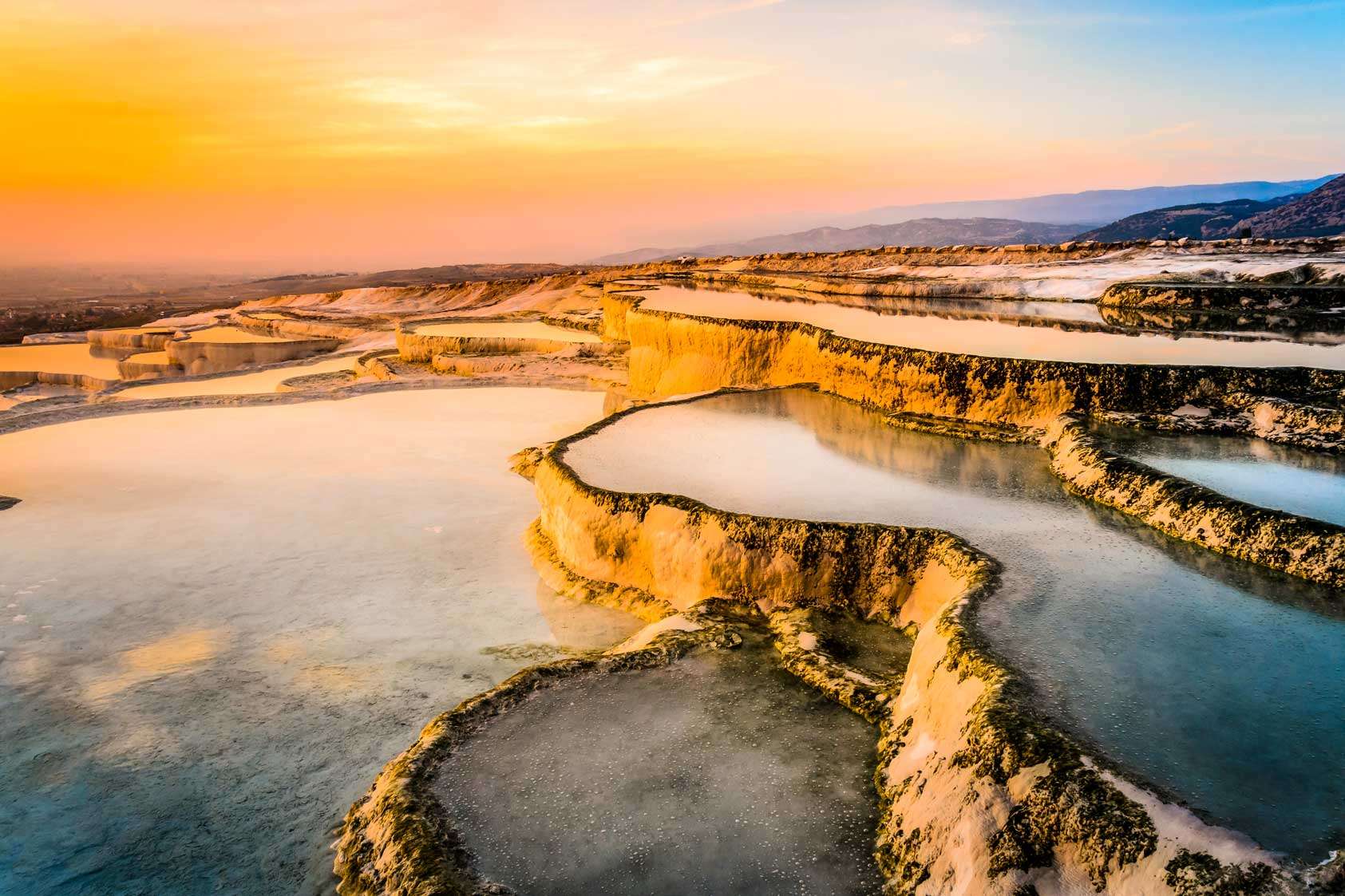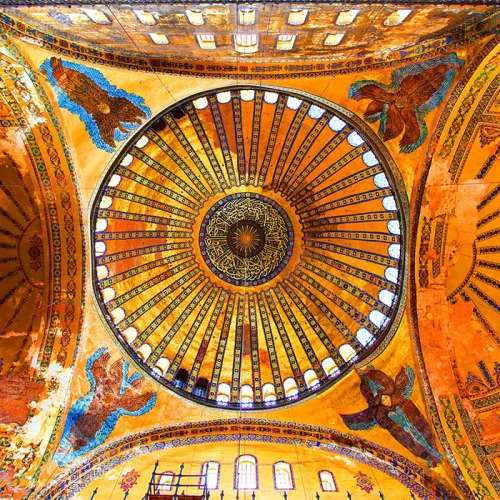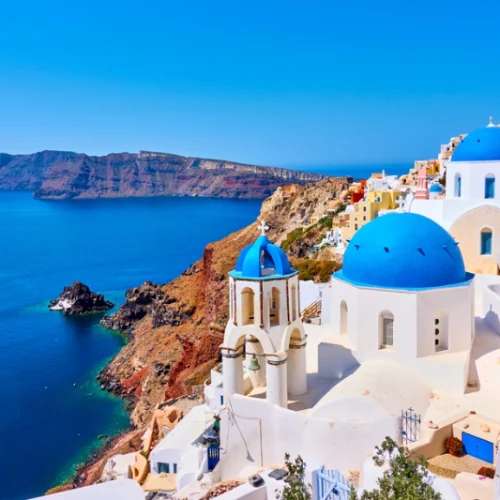
Pamukkale
Pamukkale is located in the Denizli Province of Turkey and is well connected by road, air, and rail. The closest airport is Denizli Çardak Airport.
The Historical Significance of Pamukkale

With its cascading terraces of mineral-rich thermal waters, Pamukkale is truly a sight to behold. This geological phenomenon, often referred to as the "Cotton Castle" due to its white, cotton-like appearance, is one of Turkey's most popular destinations. Nestled in the inner Aegean region, Pamukkale is a mystical blend of natural beauty and historical legacy. Here, you can immerse yourself in the warm waters while enjoying the mesmerizing view, or explore the ancient ruins that echo tales of bygone civilizations.
When you first set eyes on Pamukkale, you might think you've stepped into a winter wonderland. The terraces, made of travertine - a sedimentary rock deposited by water from the hot springs, appear like snow-covered hills. But as you step closer, the warm, inviting waters reveal the truth of this natural spectacle.
Pamukkale, in all its pristine glory, is a testament to nature's artistry. The landscape is surreal, almost otherworldly. It's a place where earth's creativity meets human history, with the ancient city of Hierapolis located right above the terraces. But before we delve into that, let's understand the historical significance of this unique destination.
Pamukkale has been a site of human settlement for thousands of years, with the earliest known inhabitants dating back to the Bronze Age. The region was particularly favored due to its thermal springs, believed to have healing properties. It was the ancient Greeks who established the city of Hierapolis around these springs, turning Pamukkale into a renowned healing center.
The city of Hierapolis, with its grand architecture and bath complexes, bore witness to the zenith of Hellenistic and Roman culture. The ruins of this ancient city, including a theater, a necropolis, and a church, offer a glimpse into the region's glorious past. Moreover, the city was also a significant center for the cult of Cybele, an Anatolian goddess, adding a spiritual dimension to its historical narrative.
Over the centuries, Hierapolis and Pamukkale continued to flourish, attracting not just the sick but also intellectuals, philosophers, and artists. Today, this historical legacy, combined with the area's natural beauty, contributes to Pamukkale's UNESCO World Heritage status.
Pamukkale is more than just an ancient site; it's also a geological marvel. The terraces are formed by a process known as travertine deposition. The thermal waters, rich in calcium bicarbonate, flow down the terraces, leaving deposits of calcium carbonate. Over time, these deposits solidify, forming the white terraces that Pamukkale is famous for. This natural wonder is a spectacle throughout the year. In the summer, the terraces glisten under the sun, while in the winter, they're often shrouded in mist, creating a magical atmosphere. But regardless of the season, the Pamukkale waters remain warm, inviting you for a soothing dip. The terraces are not the only natural feature of Pamukkale; there's also the Lake Salda. Often referred to as Turkey's Maldives, this lake is known for its turquoise waters and white sands. It's a perfect spot to relax after exploring the terraces and the ruins of Hierapolis.
Pamukkale is located in the Denizli Province of Turkey and is well connected by road, air, and rail. The closest airport is Denizli Çardak Airport, which is about an hour's drive from Pamukkale. There are regular flights from Istanbul and other major cities in Turkey to Denizli.
If you prefer to travel by train, there are daily trips from Izmir and Ankara to Denizli. From the train station, you can take a minibus or taxi to Pamukkale. Alternatively, you can take a direct bus from cities like Istanbul, Antalya, and Izmir to Denizli.
Upon reaching Denizli, you'll find regular shuttle services to Pamukkale. The trip is relatively short, about 20 minutes, and offers stunning views of the countryside.
Once you're in Pamukkale, there's no shortage of activities. Of course, the main attraction is the thermal pools. You can spend hours soaking in these warm waters, enjoying the panoramic views of the surrounding landscape.
After a relaxing bath, head to the ancient city of Hierapolis. Here, you can explore the ruins, visit the Hierapolis Archaeological Museum, and learn about the city's fascinating history.
Don't miss the chance to paraglide over Pamukkale. It's an exhilarating experience that offers a breathtaking aerial view of the white terraces and the ruins of Hierapolis. If you prefer a more laid-back activity, you can take a hot air balloon ride at sunrise.
The thermal pools of Pamukkale are the area's main attraction. The warm, mineral-rich waters are believed to have healing properties, and people have been bathing in them for thousands of years. The pools vary in depth, with some shallow enough for a relaxing foot bath, while others are deep enough for a full-body soak.
The Antique Pool is one of the most popular thermal pools in Pamukkale. Also known as Cleopatra's Pool, it is said that the Egyptian Queen herself bathed in these waters. The pool is dotted with ancient columns, remnants of the Roman Temple of Apollo, adding a historical touch to your bathing experience.
When bathing in the pools, remember to be respectful of the environment. The terraces are fragile, and any damage to them is irreversible. Always follow the guidelines and stay within the designated bathing areas.
Visiting Pamukkale is an experience like no other, but there are a few things to keep in mind to ensure a pleasant trip. First and foremost, remember to wear comfortable shoes. The terraces can be slippery, and the ground can get hot during the summer.
Second, bring a swimsuit if you plan to bathe in the thermal pools. There are changing rooms available near the pools. Also, remember to bring a towel and some sunscreen.
If you're visiting during the peak season, consider starting your day early to avoid the crowds. The site opens at 8 am, and the morning light offers some fantastic photo opportunities.
Lastly, remember to stay hydrated. The region can get quite hot, especially in the summer, and it's essential to drink plenty of water.
Pamukkale is not just a destination; it's an experience. It's a place where you can unwind, learn, and discover. With its thermal pools, ancient ruins, and unique geographical features, Pamukkale offers something for everyone.
The 'bang bang' experience in Pamukkale is a journey of exploration and discovery. It's about immersing yourself in the beauty of nature, the richness of history, and the warmth of Turkish hospitality.
So, if you're planning a trip to Turkey, make sure to include Pamukkale in your itinerary. It's a destination that will leave you with memories to cherish for a lifetime. Get your Turkey Trip Tour Now!
Related Tours

6 Days / 5 Nights
It is time to start planning your Turkey Tour 2024 and explore Istanbul and Anatolia wonders in just 6 days. Inquire Now!

6 Days / 5 Nights
Combine the rich heritage of Turkey with a magical 6-day tour on this Best of Istanbul and Southeast of Turkey tour, a must for any lover of exploration.

16 Days / 15 Nights
Embark on an incredible journey spanning 16 days, filled with thrilling adventures, immersive cultural experiences, delectable culinary delights, and countless unforgettable memories. Join us on our extraordinary tour, taking you through the captivating destinations of Turkey and Greece.








































